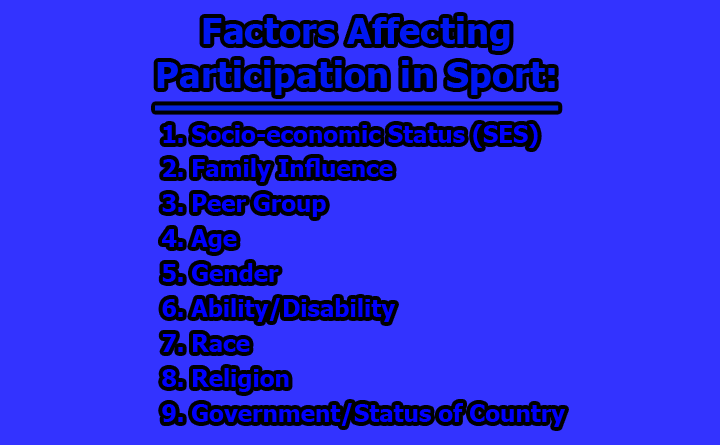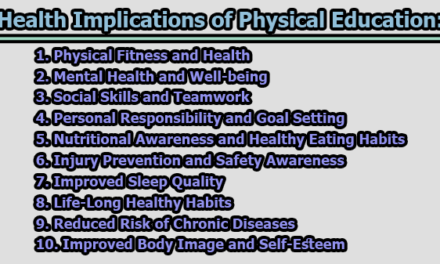Factors Affecting Participation in Sport:
Participation in sports is a global phenomenon with profound impacts on physical and mental well-being, social cohesion, and personal development. However, not everyone has equal access to and engagement in sports. Various factors, including socio-economic status, family influence, age, gender, ability/disability, race, religion, and the government’s role, play pivotal roles in shaping an individual’s involvement in sports. Let’s delve into each of the factors affecting participation in sport:
1. Socio-economic Status (SES): Socio-economic status is a multifaceted factor that encompasses an individual’s income, education, and occupation. Here’s a more detailed look at how SES influences sports participation:
- Financial Barriers: Individuals from lower SES backgrounds often face financial constraints that limit their involvement in sports. The costs associated with purchasing sports equipment, paying for club memberships, and accessing coaching or training sessions can be prohibitive. This financial barrier can lead to disparities in access to sports opportunities.
- Inequality in Facilities: Communities with higher SES tend to have better sports facilities, including well-maintained fields, courts, and gyms. These disparities in access to quality facilities can limit opportunities for individuals from lower SES backgrounds to engage in sports.
- Educational Disparities: Education is closely linked to SES, and schools play a significant role in providing sports opportunities for children. Schools in wealthier areas often have better sports programs, more resources, and experienced coaches. This advantage can lead to differences in sports participation rates among students from varying SES backgrounds.
- Transportation and Travel: Participation in competitive sports often requires traveling to competitions or training sessions. Families with lower SES may face challenges related to transportation, making it difficult for their children to access sports activities beyond their immediate community.
2. Family Influence: The family environment has a profound impact on an individual’s attitude and access to sports. Here’s a more detailed examination of how family influences sports participation:
- Role Modeling: Parents who are active in sports and prioritize physical activity set positive examples for their children. Children are more likely to engage in sports if they see their parents valuing and participating in them.
- Financial Support: Families that can afford sports equipment, coaching, and club memberships provide their children with opportunities for skill development and competitive participation. This financial support can be a critical factor in an individual’s sports journey.
- Encouragement and Support: Supportive families create a nurturing environment for young athletes. Emotional support, encouragement, and attending games or matches can boost a child’s confidence and motivation to continue participating in sports.
- Time Commitment: The family’s willingness and ability to accommodate sports schedules and commitments, such as practices and games, play a significant role in determining a child’s level of participation.
3. Peer Group: Peers have a strong influence on an individual’s decisions and interests, including sports participation. Here’s a more detailed exploration of how peer groups impact sports involvement:
- Peer Pressure: Adolescents, in particular, are susceptible to peer pressure. If a peer group values and participates in sports, individuals are more likely to follow suit to fit in and gain social acceptance.
- Social Identity: Belonging to a peer group that identifies with a specific sport or activity can lead individuals to adopt that interest as part of their own social identity. This can be a powerful motivator for continued participation.
- Competition and Camaraderie: Peer groups can provide a competitive yet supportive environment that encourages sports participation. The camaraderie and sense of belonging that come from being part of a sports team or group can be a strong motivator.
- Shared Interests: Friends who share a common interest in a sport are more likely to engage in that activity together, leading to increased participation.
4. Age: Age is a fundamental factor influencing sports participation, with evolving preferences and priorities over a person’s lifetime. Here’s a closer look at age-related considerations:
- Early Childhood Participation: Young children often engage in sports through recreational programs, schools, and community organizations. These early experiences can shape their attitudes towards sports.
- Adolescent Participation: Adolescence is a crucial period for sports involvement. Peer influence, school sports, and the pursuit of personal interests can either encourage or deter participation.
- Adulthood and Beyond: As individuals transition into adulthood, they may face competing priorities such as work, family, and other commitments. These responsibilities can limit the time and energy available for sports.
- Masters and Seniors: Some individuals continue to participate in sports as they age, often choosing activities that are less physically demanding or competitive. Recreation and socialization become key motivations for participation in later years.
5. Gender: Gender significantly impacts sports participation, leading to varying opportunities and expectations for males and females. Here’s a more detailed examination of gender-related factors:
- Stereotypes and Expectations: Societal expectations and stereotypes about gender and athleticism can deter females from participating in sports perceived as more aggressive or physically demanding. Conversely, males may face pressure to conform to traditional ideals of masculinity, which may limit their interest in certain sports.
- Gender Equity: Efforts to promote gender equity in sports have led to greater opportunities for female athletes. However, disparities still exist in terms of funding, media coverage, and representation in leadership positions within sports organizations.
- Title IX: In the United States, Title IX is a federal law that has played a significant role in expanding sports opportunities for females in educational institutions. It mandates equal access to sports programs for both genders.
- Inclusivity and Diversity: Promoting inclusivity and breaking down gender-related barriers is essential for ensuring that all individuals, regardless of their gender identity, have the opportunity to participate in sports.
6. Ability/Disability: Physical and cognitive abilities or disabilities can be critical determinants of sports participation. Here’s a closer look at how ability and disability impact sports involvement:
- Adaptive Sports: Adaptive sports have gained prominence in recent years, providing individuals with disabilities the opportunity to participate in a wide range of activities, from wheelchair basketball to para-swimming. These sports often require modified equipment and specialized coaching.
- Skill Level: Exceptional abilities can lead to specialized training and access to opportunities not available to others. Highly skilled athletes may receive scholarships, sponsorships, and recognition for their achievements.
- Inclusive Programs: Inclusive sports programs and initiatives aim to accommodate individuals with diverse abilities, fostering a sense of belonging and promoting sports as a means of physical and social development for all.
7. Race: Race and ethnicity can influence sports participation through cultural preferences, access to resources, and historical factors. Here’s a closer look at the role of race in sports:
- Cultural Preferences: Different racial and ethnic groups may have preferences for specific sports based on cultural traditions and historical significance. For example, basketball holds a prominent place in African-American communities in the United States.
- Access and Resources: Disparities in access to sports facilities, coaching, and funding can exist along racial lines, leading to inequities in sports participation rates.
- Representation: The underrepresentation of certain racial and ethnic groups in professional sports can impact the visibility of role models and influence young athletes’ aspirations.
- Diversity and Inclusion: Promoting diversity and inclusion in sports organizations and programs is crucial for addressing racial disparities and ensuring equal opportunities for all participants.
8. Religion: Religion can intersect with sports participation in various ways, impacting individuals’ ability to engage in certain activities. Here’s a more detailed exploration of the relationship between religion and sports:
- Religious Practices: Some religions have specific dietary restrictions or dress codes that may affect an individual’s ability to participate in certain sports. For example, a Muslim athlete observing fasting during Ramadan may face challenges with training and competition schedules.
- Incorporation of Sports: Some religious communities incorporate physical activities, such as martial arts or yoga, into their religious practices. This integration can promote sports participation within those communities.
- Respect for Religious Beliefs: Coaches, teams, and sports organizations should be sensitive to and respectful of the religious beliefs and practices of athletes. Accommodations may need to be made to ensure inclusivity.
9. Government/Status of Country: The role of government and the socio-political status of a country can have a profound impact on sports participation. Here’s a closer examination of these influences:
- Government Policies: Governments can shape sports participation through policies related to education, infrastructure development, funding for sports programs, and initiatives to promote physical activity. Supportive policies can enhance access to sports opportunities.
- Investment in Infrastructure: Countries that invest in sports infrastructure, including stadiums, training facilities, and recreational spaces, are more likely to offer accessible and high-quality sports experiences to their citizens.
- National Priorities: In countries with political instability or limited resources, sports may be deprioritized in favor of other pressing concerns. Economic and social stability can influence the government’s ability to promote sports as a national priority.
- Global Sporting Events: Hosting major sporting events can bring international attention and investment to a country, potentially boosting sports participation and infrastructure development.
In conclusion, participation in sports is shaped by a multitude of factors, ranging from socio-economic status and family influence to age, gender, ability/disability, race, religion, and the government’s role. Recognizing and addressing these factors is essential for promoting inclusivity and ensuring that sports opportunities are accessible to all individuals, regardless of their background or circumstances.
Efforts to break down barriers and create a more inclusive sporting environment are ongoing worldwide. By addressing these factors systematically and promoting diversity and equity in sports, we can maximize the benefits of sports participation for individuals and communities alike. Sports should be a universal and accessible avenue for physical activity, personal growth, and social cohesion.
References:
- Azevedo, M. R., Araújo, C. L. P., Silva, M. C., Hallal, P. C., & Tracking Group, B. R. (2007). “Frequent participation in sports activities by Brazilian adolescents: National Adolescent School-based Health Survey (PeNSE), 2009.” Cadernos de Saúde Pública, 23(4), 730-740.
- Coakley, J. (2015). “Sports in Society: Issues and Controversies.” McGraw-Hill Education.
- Cunningham, G. B., & Sagas, M. (2005). “Factors influencing sport media consumption: A preliminary investigation.” International Journal of Sports Marketing and Sponsorship, 6(4), 270-286.
- Eime, R. M., Young, J. A., Harvey, J. T., Charity, M. J., & Payne, W. R. (2013). “A systematic review of the psychological and social benefits of participation in sport for children and adolescents: Informing development of a conceptual model of health through sport.” International Journal of Behavioral Nutrition and Physical Activity, 10(1), 1-21.
- Lyras, A., & Peachey, J. W. (2011). “Perceived barriers to youth participation in extracurricular sport activities.” Recreational Sports Journal, 35(1), 65-80.
- Malina, R. M. (2010). “Early sport specialization: Roots, effectiveness, risks.” Current Sports Medicine Reports, 9(6), 364-371.
- Spaaij, R. (2013). “Sport as a vehicle for social mobility and regulation of marginalized urban youth: Lessons from Rotterdam.” In Routledge Handbook of Sport and Corporate Social Responsibility (pp. 69-82). Routledge.
- Stodolska, M., & Alexandris, K. (2004). “Participation in recreational physical activities: A review of research focusing on the immigrant experience.” Leisure Sciences, 26(2), 143-163.
- Wicker, P., Breuer, C., & Pawlowski, T. (2012). “Moneyball in professional team sports: The impact of payroll disparity on performance.” European Sport Management Quarterly, 12(4), 363-378.
- Yerkes, M. A., & Dodson, C. T. (1908). “The relation of strength of stimulus to rapidity of habit-formation.” Journal of Comparative Neurology and Psychology, 18(5), 459-482.

Library Lecturer at Nurul Amin Degree College










